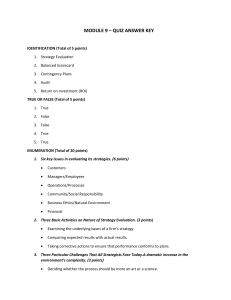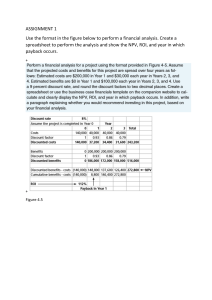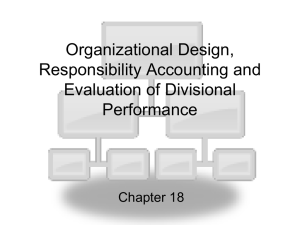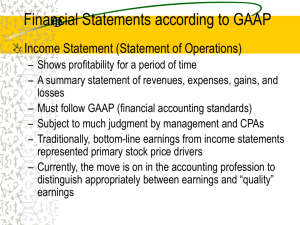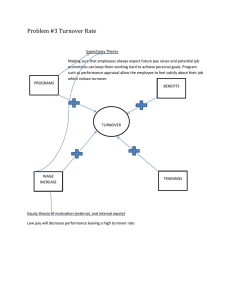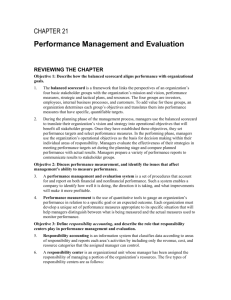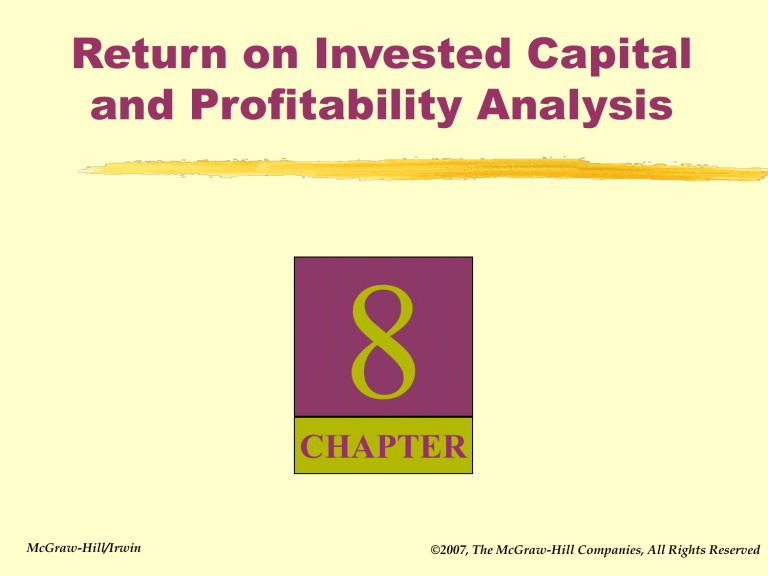
Return on Invested Capital and Profitability Analysis 8 CHAPTER McGraw-Hill/Irwin ©2007, The McGraw-Hill Companies, All Rights Reserved Return on Invested Capital Importance of Joint Analysis • Joint analysis is where one measure is assessed relative to another • Return on invested capital (ROIC) is an important joint analysis Return on Invested Capital ROI Relation • ROI relates income, or other performance measure, to a company’s level and source of financing • ROI allows comparisons with alternative investment opportunities • Riskier investments are expected to yield a higher ROI • ROI impacts a company’s ability to succeed, attract financing, repay creditors,and reward owners Return on Invested Capital Application of ROI ROI is applicable to: (1) measuring managerial effectiveness (3) earnings forecasting (2) measuring profitability (3) Measure for planning and control Return on Invested Capital Measuring Managerial Effectiveness • Management is responsible for all company activities • ROI is a measure of managerial effectiveness in business activities • ROI depends on the skill, resourcefulness, ingenuity, and motivation of management Return on Invested Capital Measuring Profitability • ROI is an indicator of company profitability • ROI relates key summary measures: profits with financing • ROI conveys return on invested capital from different financing perspectives Return on Invested Capital Measurement for Planning and Control ROI assists managers with: • • • • • Planning Budgeting Coordinating activities Evaluating opportunities Control Components of ROI Definition Return on invested capital is defined as: Income Inv estedcapital Components of ROI Invested Capital Defined • No universal measure of invested capital exists • Different measures of invested capital reflect different financiers’ perspectives Components of ROI Alternative Measures of Invested Capital Common Measures: • Net Operating Assets • Stockholders’ Equity Components of ROI Net Operating Assets • Perspective is that of the company as a whole • Called return on net operating assets (RNOA) RNOA: measures operating efficiency/ performance reflects return on net operating assets (excluding financial assets/liabilities) Components of ROI Net Operating Assets 1. Net Operating Working Capital (excluding S-T investments and borrowings) 2. L-T Operating assets less L-T operating Liabilities Components of ROI Common Equity Capital • Perspective is that of common equity holders • Captures the effect of leverage (debt) capital on equity holder return • Excludes all debt financing and preferred equity Components of ROI Computing Invested Capital • Usually computed using average capital available for the period • Typically add beginning and ending invested capital amounts and divide by 2 • More accurate computation is to average interim amounts — quarterly or monthly Components of ROI Income Defined • Definition of income (return) depends on definition of invested capital • Measures of income in computing return on invested capital must reflect all applicable expenses from the perspective of the capital contributors • Income taxes are valid deductions in computing income for return on invested capital Examples: • Return on net operating assets capital uses net operating profit after tax (NOPAT) • Return on common equity capital uses net income less preferred dividends (not an expense in computing net income) Components of ROI Adjustments to Invested Capital and Income Numbers Many accounting numbers require analytical adjustment—see prior chapters Some numbers not reported in financial statements need to be included Such adjustments are necessary for effective analysis of return on invested capital Components of ROI Return on Net Operating Assets -- RNOA NOPAT (Beginning NOA Ending NOA) 2 Where • NOPAT = Operating income x (1- tax rate) • NOA = net operating assets Components of ROI Return on Common Equity -- ROCE Net Income - Preferred Dividends (Beginning Equity Ending Equity) 2 Where • Equity is stockholders’ equity less preferred stock Analyzing Return on Assets--ROA Disaggregating RNOA Return on operating assets = Operating Profit margin x Operating Asset turnover NOPAT NOPAT Sales Avg. NOA Sales Avg. NOA Operating Profit margin: measures operating profitability relative to sales Operating Asset turnover (utilization): measures effectiveness in generating sales from operating assets Effect of Operating Leverage on RNOA OA = operating assets OLLEV = operating liabilities leverage ratio (operating liabilities / NOA) Analyzing Return on Assets--ROA Relation Between Profit Margin and Asset Turnover Profit margin and asset turnover are interdependent Relation between Profit Margin, Asset Turnover, and Return on Assets Asset turnover 3.75 3.5 3.25 3 2.75 2.5 2.25 2 1.75 1.5 1.25 1 0.75 C 0.5 0.25 0 -2 -1 A D Y E B K L F M G N H X O I J P 0 1 2 3 4 5 6 7 8 9 Profit margins % 10 11 12 13 14 15 16 Net operating Asset Turnover vs. Net operating Profit Margin for Selected Industries Analyzing Return on Assets--ROA Relation Between Profit Margin and Asset Turnover Analyzing Return on Assets--ROA Disaggregating Profit Margin Gross Profit Margin: Reflects the gross profit as a percent of sales - Reflects the company’s ability to increase or maintain selling price - Declining gross profit margins generally indicate that competition has increased or that the company’s products have become less competitive, or both. Operating Expense Margin: Measures the company’s ability to control operating expenses - need to be aware of “investment” costs, like advertising and R&D. Reductions can lead to a short-term gain at a long-term cost. Analyzing Return on Assets--ROA Asset Turnover Analysis • Asset turnover measures the intensity with which companies utilize assets • Relevant measure is the amount of sales generated Analyzing Return on Assets--ROA Disaggregating Asset turnover Accounts Receivable turnover: Reflects how many times receivables are collected on average. The accompanying ratio is the average collection period. Inventories turnover: Reflects how many times inventories are collected on average. The accompanying ratio is the average inventory days outstanding. Long-term Operating Asset turnover: Reflects the productivity of long-term operating assets. Accounts Payable turnover: Reflects how quickly accounts payable are paid, on average. The accompanying ratio is the average payable days outstanding. Analyzing Return on Common Equity--ROCE Role in Equity Valuation This can be restated in terms of future ROCE: where ROCE is equal to net income available to common shareholders (after preferred dividends) divided by the beginning-of-period common equity Analyzing Return on Common Equity--ROCE Disaggregating ROCE Analyzing Return on Common Equity--ROA Leverage and ROCE • Leverage refers to the extent of invested capital from other than common shareholders • If suppliers of capital (other than common shareholders) receive less than ROA, then common shareholders benefit; the reverse occurs when suppliers of capital receive more than ROA • The larger the difference in returns between common equity and other capital suppliers, the more successful (or unsuccessful) is the trading on the equity Analyzing Return on Common Equity--ROCE Alternate View of ROCE Disaggregation Analyzing Return on Common Equity--ROCE Assessing Equity Growth Equity growth rate = Net income Preferred dividends Dividend payout Average common stockholders’ equity • Assumes earnings retention and a constant dividend payout • Assesses common equity growth rate through earnings retention Analyzing Return on Common Equity--ROCE Assessing Equity Growth Sustainabl e equity growth rate = ROCE (1Payout rate) Assumes internal growth depends on both earnings retention and return earned on the earnings retained


